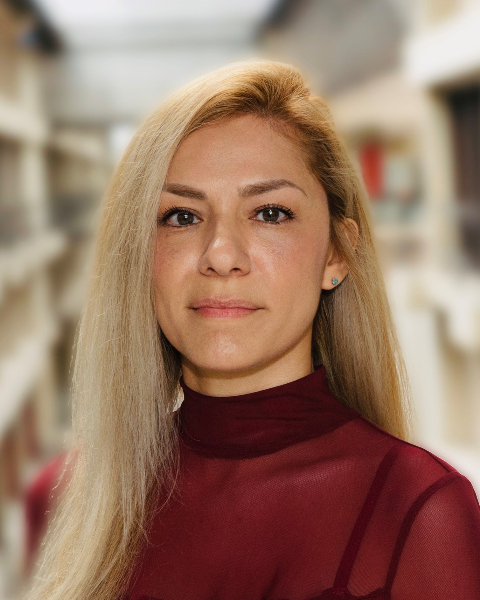PQA 05 - PQA 05: Breast Cancer and Nonmalignant Disease Poster Q&A
2737 - Thermal Dose-Effect on Locoregional Control in Locoregional Recurrent Breast Cancer Patients
Monday, September 30, 2024
3:00 PM - 4:00 PM ET
Location: Hall C
Screen: 3

C. Paola Tello Valverde, MS
Amsterdam University Medical Center (AUMC)
Amsterdam, Noord-Holl
Presenter(s)
C. P. Tello Valverde1,2, A. Bakker1, W. Kolff1, G. van Tienhoven1, H. P. Kok1, B. J. Slotman3, K. Pateras4, and H. Crezee1; 1Amsterdam University Medical Centers, Department of Radiation Oncology - Location AMC, Amsterdam, Netherlands, 2Amsterdam University Medical Centers, Department of Radiation Oncology - Location VUmc, Amsterdam, Netherlands, 3Amsterdam University Medical Centers, Department of Radiation Oncology, Amsterdam, Netherlands, 4University of Thessaly, Faculty of Public and One Health, Laboratory of Epidemiology & Artificial Intelligence, Karditsa, Greece
Purpose/Objective(s): Mild hyperthermia (39-43°C) combined with re-irradiation improves complete response compared with re-irradiation alone in locoregional recurrent (LRR) breast cancer. Observational studies analyzing a dichotomized hyperthermia thermal dose (TD) parameter showed that higher hyperthermia TD was associated with better tumor response rate compared with a lower TD. Analyzing the TD-effect relationships utilizing a continuous TD parameter would be more powerful, but has not been done so far. We therefore investigated the effect of a continuous TD parameter on locoregional control (LRC) for predicting LRC in patients with LRR breast cancer treated with postoperative re-irradiation and hyperthermia. Materials/
Methods: In this study, we retrospectively analyzed the data of 112 women with LRR breast cancer treated in 2010-2017 with postoperative re-irradiation 8x4Gy (n=34) or 23x2Gy (n=78), combined with 4-5 weekly hyperthermia sessions guided by invasive thermometry. Among possible parametrizations of CEM43 (cumulative equivalent minutes at 43°C), including the TD parameter based on time-temperature exposures, the logarithm of the session with the highest invasively measured dose CEM43T50 (median CEM43) was selected based on Weibull univariate and stepwise regression analyses. The best fitted locoregional control model was further analyzed under a Bayesian paradigm, assuming 3 informative priors (continuous highest CEM43T50, tumor location breast/chest wall and lymph node involvement).
Results: Twenty-four patients (21.4%) developed an infield recurrence; the median time to recurrence was 3.4 years (interquartile range (IQR) 2.7–4.6 years). Median highest session CEM43T50 was 7.2 minutes (equivalent to a median temperature T50 of ~40.5°C), with an IQR between 2.4–15.9 minutes. Continuous TD parameter analysis showed that a higher TD was significantly associated with an increasing LRC (P=0.001). Univariate and multivariate Weibull regression analysis showed that over the continuous TD range a twofold increase of TD (equivalent to a ~0.5°C temperature increase) was associated with a decrease of 47% (hazard ratio, 95% confidence interval (CI) 18%-84%) and 28% in hazard ratio for LRR (adjusted hazard ratio, 95% CI 4%-56%), respectively. Bayesian survival regressions lead to a range of comparable decreasing hazard ratios of recurrence when TD increased. These findings were robust under both an optimistic and a skeptic informative prior assumption on the effect of TD.
Conclusion: Twofold increase of hyperthermia TD was associated with a significant increase in LRC over the continuous TD range during hyperthermia treatment and postoperative re-irradiation in LRR breast cancer. This result has implications for the importance of achieving excellent dose control during treatment delivery and suggests an Arrhenius-like therapeutic molecular hyperthermia effect in treatment with re-irradiation and hyperthermia.
Purpose/Objective(s): Mild hyperthermia (39-43°C) combined with re-irradiation improves complete response compared with re-irradiation alone in locoregional recurrent (LRR) breast cancer. Observational studies analyzing a dichotomized hyperthermia thermal dose (TD) parameter showed that higher hyperthermia TD was associated with better tumor response rate compared with a lower TD. Analyzing the TD-effect relationships utilizing a continuous TD parameter would be more powerful, but has not been done so far. We therefore investigated the effect of a continuous TD parameter on locoregional control (LRC) for predicting LRC in patients with LRR breast cancer treated with postoperative re-irradiation and hyperthermia. Materials/
Methods: In this study, we retrospectively analyzed the data of 112 women with LRR breast cancer treated in 2010-2017 with postoperative re-irradiation 8x4Gy (n=34) or 23x2Gy (n=78), combined with 4-5 weekly hyperthermia sessions guided by invasive thermometry. Among possible parametrizations of CEM43 (cumulative equivalent minutes at 43°C), including the TD parameter based on time-temperature exposures, the logarithm of the session with the highest invasively measured dose CEM43T50 (median CEM43) was selected based on Weibull univariate and stepwise regression analyses. The best fitted locoregional control model was further analyzed under a Bayesian paradigm, assuming 3 informative priors (continuous highest CEM43T50, tumor location breast/chest wall and lymph node involvement).
Results: Twenty-four patients (21.4%) developed an infield recurrence; the median time to recurrence was 3.4 years (interquartile range (IQR) 2.7–4.6 years). Median highest session CEM43T50 was 7.2 minutes (equivalent to a median temperature T50 of ~40.5°C), with an IQR between 2.4–15.9 minutes. Continuous TD parameter analysis showed that a higher TD was significantly associated with an increasing LRC (P=0.001). Univariate and multivariate Weibull regression analysis showed that over the continuous TD range a twofold increase of TD (equivalent to a ~0.5°C temperature increase) was associated with a decrease of 47% (hazard ratio, 95% confidence interval (CI) 18%-84%) and 28% in hazard ratio for LRR (adjusted hazard ratio, 95% CI 4%-56%), respectively. Bayesian survival regressions lead to a range of comparable decreasing hazard ratios of recurrence when TD increased. These findings were robust under both an optimistic and a skeptic informative prior assumption on the effect of TD.
Conclusion: Twofold increase of hyperthermia TD was associated with a significant increase in LRC over the continuous TD range during hyperthermia treatment and postoperative re-irradiation in LRR breast cancer. This result has implications for the importance of achieving excellent dose control during treatment delivery and suggests an Arrhenius-like therapeutic molecular hyperthermia effect in treatment with re-irradiation and hyperthermia.
